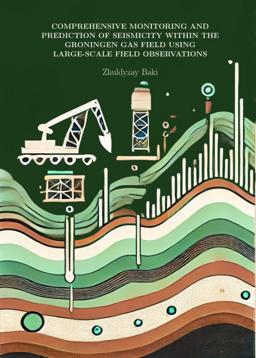2025-03-11
Comprehensive monitoring and prediction of seismicity within the Groningen gas field using large-scale field observations
Publication
Publication
This dissertation addresses the critical issue of induced seismicity within the Groningen gas field, one of the largest natural gas reservoirs globally. Since its discovery in the 1960s, the Groningen field has played a pivotal role in meeting the energy needs of the Netherlands. However, decades of sustained gas extraction have resulted in significant seismic activity in what was previously a tectonically inactive region. These induced earthquakes have raised pressing public safety concerns, necessitating a comprehensive understanding of the underlying processes, alongside the development of robust methodologies for monitoring and predicting seismic events. The aim of this research is to advance the monitoring, analysis, and prediction of seismicity by integrating statistical models with geomechanical insights and decision-making frameworks. Specifically, this study seeks to analyse the spatial and temporal patterns of seismic activity, predict future earthquake occurrences using spatio-temporal models, and optimise production strategies while mitigating seismic risk. Conducted within the framework of the DeepNL programme by the Dutch Research Council (NWO), this work forms part of a broader effort to deepen understanding of subsurface dynamics influenced by anthropogenic activities. A multidisciplinary methodological approach was employed to achieve the study objectives. The research relies on an extensive dataset comprising seismic event records provided by KNMI (covering magnitudes ≥ 1.5 from 1995 to 2023), historical gas production data, pore pressure measurements from boreholes, and NAM’s dynamic reservoir model output. Rigorous data cleaning and integration procedures ensured the datasets’ reliability, which formed the basis for subsequent statistical analyses. The study begins with a detailed temporal and spatial analysis of seismic activity. Temporal trends were examined using Poisson point processes, which allowed for the identification of earthquake timing patterns. Moreover, adaptive kernel estimation techniques were employed to detect spatial clustering of seismic events, particularly in regions experiencing significant pore pressure depletion. Building upon these initial analyses, spatio-temporal Cox processes were applied to model earthquake intensity more comprehensively. This approach was enhanced by incorporating covariates derived from pore pressure estimates using polynomial kriging and Bayesian inference methods, thereby improving the predictive accuracy of seismic hazard assessments. An important advancement of this research lies in integrating NAM’s dynamic reservoir model with the spatio-temporal Cox process framework. This integration enabled the incorporation of physical processes, such as stress build-up and reservoir compaction, into the statistical models, thus bridging the gap between geomechanical insights and statistical predictions. To address the practical challenge of balancing gas production targets with seismic hazard mitigation, this dissertation introduces a decision-making framework based on Markov Decision Processes (MDPs). This framework allows for optimising production policies by accounting for seismic risk and resource extraction goals. By formulating and evaluating various production scenarios, the MDP framework provides a structured and data-driven approach to decision-making under uncertainty. The findings of this research reveal a clear relationship between gas extraction, pore pressure depletion, and seismic activity, with significant clustering of earthquakes observed in regions of pronounced reservoir compaction. The enhanced predictive models, which integrate geomechanical and statistical techniques, offer an improvement in seismic hazard assessments. Furthermore, the decision-making framework demonstrates its utility in supporting safer and more sustainable production strategies. In conclusion, this dissertation advances the state of knowledge on induced seismicity in the Groningen gas field by presenting a robust, interdisciplinary framework for seismic monitoring, prediction, and mitigation. The integration of statistical models, geomechanical data, and decision-making tools provides a comprehensive approach to managing seismic risk. While the findings are directly relevant to the Groningen gas field, the methodologies developed herein have broader applicability to other regions and contexts where resource extraction induces seismic activity. Future research should focus on incorporating additional geological variables, real-time data assimilation for dynamic hazard assessment, and extending the decision-making framework to other subsurface activities.
| Additional Metadata | |
|---|---|
| M.N.M. van Lieshout (Marie-Colette) | |
| Schlottbom (Matthias) | |
| Universiteit Twente | |
| Organisation | Stochastics |
|
Baki, Z. (2025, March 11). Comprehensive monitoring and prediction of seismicity within the Groningen gas field using large-scale field observations. |
|

